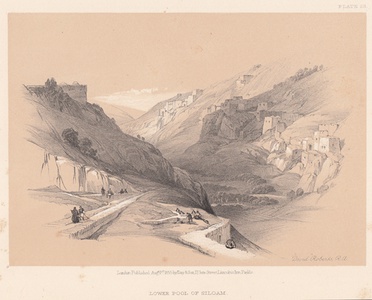| Method | Lithograph with tint stone |
| Artist | after David Roberts |
| Published | London, Published Augt. 1st. 1855, by Day & Son, 17, Gate Street, Lincoln's Inn Fields |
| Dimensions | Image 128 x 182 mm, Sheet 202 x 285 mm |
| Notes |
Plate 23 from Volume 1 of the small format reprint of Roberts' The Holy Land, Syria, Idumea, Arabia, Egypt & Nubia. A view of the lower section of the Gihon Spring, in the Kidron Valley near the Old City of Jerusalem. The Gihon spring is one of only a few historical rhythmic springs in the world, providing an intermittent flow of water throughout the day. The spring is of great cultural and historical purpose, having been the main source of water for the City of David, the ancient Jerusalem. Due to its intermittent nature, the water from the spring was collected in the Pool of Siloam, an excavated reservoir close by. In addition to its peculiar intermittent flow, the springs output also varies throughout the year, flowing from five time a day in winter to only once in autumn. In the time of Hezekiah, a shaft was cut into the rock to join the spring to the Pool of Siloam. Roberts' view shows this stone-lined aqueduct flowing down the valley towards the reservoir. Groups of men gather on the walls of the reservoirs, while a pair of guards stand on the water channel itself. On the opposite side of the valley, numerous houses are built onto the terraces and slopes. David Roberts RA (24th October 1796 – 25th November 1864) was a Scottish painter. He is especially known for a prolific series of detailed prints of Egypt and the Near East produced during the 1840s from sketches made during long tours of the region (1838-1840). This work, and his large oil paintings of similar subjects, made him a prominent Orientalist painter. He was elected as a Royal Academician in 1841. The firm of Day & Haghe was one of the most prominent lithographic companies of the nineteenth-century. They were also amongst the foremost pioneers in the evolution of chromolithography. The firm was established in 1823 by William Day, but did not trade under the moniker of Day & Haghe until the arrival of Louis Haghe in 1831. In 1838, Day & Haghe were appointed as Lithographers to the Queen. However, and perhaps owing to the fact that there was never a formal partnership between the two, Haghe left the firm in the 1850's to devote himself to watercolour painting. The firm continued as Day & Son under the guidance of William Day the younger (1823 - 1906) but, as a result of a scandal involving Lajos Kossuth, was forced into liquidation in 1867. Vincent Brookes bought the company in the same year, and would produce the caricatures for Gibson Bowles' Vanity Fair magazine, as well as the illustrations for Cassells's Poultry Book, amongst other commissions. Condition: Foxing to margins, not affecting image. |
| Framing | unmounted |
| Price | £25.00 |
| Stock ID | 39338 |

